Draft Genome Assembly of Parnassius epaphus Provides New Insights into Transposable Elements That Drive Genome Expansion in Alpine Parnassius butterflies
Abstract
1. Introduction
2. Materials and Methods
2.1. Sample Collection and DNA Extraction
2.2. Genome Sequencing
2.3. Genome Assembly and Quality Assessment
2.4. Genome Annotation and Transposable Element Identification
2.5. Statistical Analysis and Visualization
3. Results
3.1. P. epaphus Genome Assembly
3.2. Genomic Expansion and Repetitive Element Diversification in Parnassius Butterflies
3.3. Evolutionary Dynamics of Transposable Elements in Parnassius Butterflies
4. Discussion
4.1. Transposable Elements as Architects of Genome Expansion in Extreme Environments
4.2. Evolutionary Stratification of TE Landscapes Across Altitude Gradients
4.3. Transposable Elements as Adaptive Mechanisms in Extreme Environments
4.4. Future Directions
Supplementary Materials
Author Contributions
Funding
Data Availability Statement
Conflicts of Interest
References
- Hayward, A.; Gilbert, C. Transposable elements. Curr. Biol. 2022, 32, R904–R909. [Google Scholar] [CrossRef]
- Feschotte, C. Transposable elements: McClintock’s legacy revisited. Nat. Rev. Genet. 2023, 24, 797–800. [Google Scholar] [CrossRef]
- Wells, J.N.; Feschotte, C. A Field Guide to Eukaryotic Transposable Elements. Annu. Rev. Genet. 2020, 54, 539–561. [Google Scholar] [CrossRef]
- Zhang, C.; Wang, L.; Dou, L.; Yue, B.; Xing, J.; Li, J. Transposable Elements Shape the Genome Diversity and the Evolution of Noctuidae Species. Genes 2023, 14, 1244. [Google Scholar] [CrossRef] [PubMed]
- Gilbert, C.; Peccoud, J.; Cordaux, R. Transposable Elements and the Evolution of Insects. Annu. Rev. Entomol. 2021, 66, 355–372. [Google Scholar] [CrossRef]
- Mackay, T.F. Transposable elements and fitness in Drosophila melanogaster. Genome 1989, 31, 284–295. [Google Scholar] [CrossRef] [PubMed]
- Lozovskaya, E.R.; Hartl, D.L.; Petrov, D.A. Genomic regulation of transposable elements in Drosophila. Curr. Opin. Genet. Dev. 1995, 5, 768–773. [Google Scholar] [CrossRef] [PubMed]
- Adrion, J.R.; Begun, D.J.; Hahn, M.W. Patterns of transposable element variation and clinality in Drosophila. Mol. Ecol. 2019, 28, 1523–1536. [Google Scholar] [CrossRef]
- Liu, X.; Majid, M.; Yuan, H.; Chang, H.; Zhao, L.; Nie, Y.; He, L.; Liu, X.; He, X.; Huang, Y. Transposable element expansion and low-level piRNA silencing in grasshoppers may cause genome gigantism. BMC Biol. 2022, 20, 243. [Google Scholar] [CrossRef]
- Zhao, Y.; Su, C.; He, B.; Nie, R.; Wang, Y.; Ma, J.; Song, J.; Yang, Q.; Hao, J. Dispersal from the Qinghai-Tibet plateau by a high-altitude butterfly is associated with rapid expansion and reorganization of its genome. Nat. Commun. 2023, 14, 8190. [Google Scholar] [CrossRef]
- Höglund, J.; Dias, G.; Olsen, R.A.; Soares, A.; Bunikis, I.; Talla, V.; Backström, N. A Chromosome-Level Genome Assembly and Annotation for the Clouded Apollo Butterfly (Parnassius mnemosyne): A Species of Global Conservation Concern. Genome Biol. Evol. 2024, 16, evae031. [Google Scholar] [CrossRef] [PubMed]
- Su, C.; Ding, C.; Zhao, Y.; He, B.; Nie, R.; Hao, J. Diapause-Linked Gene Expression Pattern and Related Candidate Duplicated Genes of the Mountain Butterfly Parnassius glacialis (Lepidoptera: Papilionidae) Revealed by Comprehensive Transcriptome Profiling. Int. J. Mol. Sci. 2023, 24, 5577. [Google Scholar] [CrossRef]
- Tao, R.; Xu, C.; Wang, Y.; Sun, X.; Li, C.; Ma, J.; Hao, J.; Yang, Q. Spatiotemporal Differentiation of Alpine Butterfly Parnassius glacialis (Papilionidae: Parnassiinae) in China: Evidence from Mitochondrial DNA and Nuclear Single Nucleotide Polymorphisms. Genes 2020, 11, 188. [Google Scholar] [CrossRef]
- Koo, K.A.; Park, S.U. A Dark Future of Endangered Mountain Species, Parnassius bremeri, Under Climate Change. Ecol. Evol. 2025, 15, e71178. [Google Scholar] [CrossRef]
- Ding, C.; Su, C.; Li, Y.; Zhao, Y.; Wang, Y.; Wang, Y.; Nie, R.; He, B.; Ma, J.; Hao, J. Interspecific and Intraspecific Transcriptomic Variations Unveil the Potential High-Altitude Adaptation Mechanisms of the Parnassius Butterfly Species. Genes 2024, 15, 1013. [Google Scholar] [CrossRef]
- Podsiadlowski, L.; Tunström, K.; Espeland, M.; Wheat, C.W. The Genome Assembly and Annotation of the Apollo Butterfly Parnassius apollo, a Flagship Species for Conservation Biology. Genome Biol. Evol. 2021, 13, evab122. [Google Scholar] [CrossRef]
- Matsushita, A.; Awata, H.; Wakakuwa, M.; Takemura, S.Y.; Arikawa, K. Rhabdom evolution in butterflies: Insights from the uniquely tiered and heterogeneous ommatidia of the Glacial Apollo butterfly, Parnassius glacialis. Proc. R. Soc. B Biol. Sci. 2012, 279, 3482–3490. [Google Scholar] [CrossRef]
- Si, C.; Chen, K.; Hao, J. The complete mitochondrial genome of Parnassius mercurius Grum-Grshimailo (Lepidoptera: Papilionidae: Parnassiinae). Mitochondrial DNA Part B Resour. 2020, 5, 538–540. [Google Scholar] [CrossRef] [PubMed]
- Das, G.N.; Ali, M.; Bálint, Z.; Singh, N.; Chandra, K.; Gupta, S.K. Visiting Ladakh Himalaya for a better knowledge of butterflies: New faunistic data with annotations (Lepidoptera, Papilionoidea). Zootaxa 2023, 5271, 401–445. [Google Scholar] [CrossRef] [PubMed]
- Chikhi, R.; Medvedev, P. Informed and automated k-mer size selection for genome assembly. Bioinformatics 2014, 30, 31–37. [Google Scholar] [CrossRef]
- Hu, J.; Wang, Z.; Sun, Z.; Hu, B.; Ayoola, A.O.; Liang, F.; Li, J.; Sandoval, J.R.; Cooper, D.N.; Ye, K.; et al. NextDenovo: An efficient error correction and accurate assembly tool for noisy long reads. Genome Biol. 2024, 25, 107. [Google Scholar] [CrossRef]
- Guan, D.; McCarthy, S.A.; Wood, J.; Howe, K.; Wang, Y.; Durbin, R. Identifying and removing haplotypic duplication in primary genome assemblies. Bioinformatics 2020, 36, 2896–2898. [Google Scholar] [CrossRef] [PubMed]
- Seppey, M.; Manni, M.; Zdobnov, E.M. BUSCO: Assessing Genome Assembly and Annotation Completeness. Methods Mol. Biol. 2019, 1962, 227–245. [Google Scholar] [PubMed]
- Baril, T.; Galbraith, J.; Hayward, A. Earl Grey: A Fully Automated User-Friendly Transposable Element Annotation and Analysis Pipeline. Mol. Biol. Evol. 2024, 41, msae068. [Google Scholar] [CrossRef]
- Li, H. Protein-to-genome alignment with miniprot. Bioinformatics 2023, 39, btad014. [Google Scholar] [CrossRef] [PubMed]
- R Core Team. R: A Language and Environment for Statistical Computing 2014; R Foundation for Statistical Computing: Vienna, Austria, 2008. [Google Scholar]
- Krzywinski, M.; Schein, J.; Birol, I.; Connors, J.; Gascoyne, R.; Horsman, D.; Jones, S.J.; Marra, M.A. Circos: An information aesthetic for comparative genomics. Genome Res. 2009, 19, 1639–1645. [Google Scholar] [CrossRef]
- Lyu, F.; Han, F.; Ge, C.; Mao, W.; Chen, L.; Hu, H.; Chen, G.; Lang, Q.; Fang, C. OmicStudio: A composable bioinformatics cloud platform with real-time feedback that can generate high-quality graphs for publication. iMeta 2023, 2, e85. [Google Scholar] [CrossRef]
- Su, C.; Xie, T.; Wang, Y.; Si, C.; Li, L.; Ma, J.; Li, C.; Sun, X.; Hao, J.; Yang, Q. Miocene Diversification and High-Altitude Adaptation of Parnassius Butterflies (Lepidoptera: Papilionidae) in Qinghai-Tibet Plateau Revealed by Large-Scale Transcriptomic Data. Insects 2020, 11, 754. [Google Scholar] [CrossRef]
- Bílá, K.; Šipoš, J.; Kindlmann, P.; Kuras, T. Consequences for selected high-elevation butterflies and moths from the spread of Pinus mugo into the alpine zone in the High Sudetes Mountains. PeerJ 2016, 4, e2094. [Google Scholar] [CrossRef]
- Talla, V.; Suh, A.; Kalsoom, F.; Dinca, V.; Vila, R.; Friberg, M.; Wiklund, C.; Backström, N. Rapid Increase in Genome Size as a Consequence of Transposable Element Hyperactivity in Wood-White (Leptidea) Butterflies. Genome Biol. Evol. 2017, 9, 2491–2505. [Google Scholar] [CrossRef]
- Meglecz, E.; Petenian, F.; Danchin, E.; D’Acier, A.C.; Rasplus, J.Y.; Faure, E. High similarity between flanking regions of different microsatellites detected within each of two species of Lepidoptera: Parnassius apollo and Euphydryas aurinia. Mol. Ecol. 2004, 13, 1693–1700. [Google Scholar] [CrossRef]
- Zhang, H.; Zhang, P.; Niu, Y.; Tao, T.; Liu, G.; Dong, C.; Zheng, Z.; Zhang, Z.; Li, Y.; Niu, Z.; et al. Genetic basis of camouflage in an alpine plant and its long-term co-evolution with an insect herbivore. Nat. Ecol. Evol. 2025, 9, 628–638. [Google Scholar] [CrossRef]
- Chen, Y.J.; Zhu, L.; Wu, Q.N.; Hu, C.C.; Qu, Y.F.; Ji, X. Geological and climatic influences on population differentiation of the Phrynocephalus vlangalii species complex (Sauria: Agamidae) in the northern Qinghai-Tibet Plateau. Mol. Phylogenetics Evol. 2022, 169, 107394. [Google Scholar] [CrossRef]
- Chen, K.; Wang, B.; Chen, C.; Zhou, G. The relationship between niche breadth and phylogenetic characteristics of eight species of rhubarb on the Qinghai-Tibet Plateau, Asia. Ecol. Evol. 2024, 14, e11040. [Google Scholar] [CrossRef]
- Xiao, S.J.; Mou, Z.B.; Yang, R.B.; Fan, D.D.; Liu, J.Q.; Zou, Y.; Zhu, S.L.; Zou, M.; Zhou, C.W.; Liu, H.P. Genome and population evolution and environmental adaptation of Glyptosternon maculatum on the Qinghai-Tibet Plateau. Zool. Res. 2021, 42, 502–513. [Google Scholar] [CrossRef] [PubMed]
- Meng, Q.; Xie, Z.; Xu, H.; Guo, J.; Tang, Y.; Ma, T.; Peng, Q.; Wang, B.; Mao, Y.; Yan, S.; et al. Out of the Qinghai-Tibetan plateau: Origin, evolution and historical biogeography of Morchella (both Elata and Esculenta clades). Front. Microbiol. 2022, 13, 1078663. [Google Scholar] [CrossRef] [PubMed]
- Geng, Y.; Guan, Y.; Qiong, L.; Lu, S.; An, M.; Crabbe, M.J.C.; Qi, J.; Zhao, F.; Qiao, Q.; Zhang, T. Genomic analysis of field pennycress (Thlaspi arvense) provides insights into mechanisms of adaptation to high elevation. BMC Biol. 2021, 19, 143. [Google Scholar] [CrossRef]
- Yu, W.B.; Randle, C.P.; Lu, L.; Wang, H.; Yang, J.B.; dePamphilis, C.W.; Corlett, R.T.; Li, D.Z. The Hemiparasitic Plant Phtheirospermum (Orobanchaceae) Is Polyphyletic and Contains Cryptic Species in the Hengduan Mountains of Southwest China. Front. Plant Sci. 2018, 9, 142. [Google Scholar] [CrossRef] [PubMed]
- Zhu, Z.; Su, C.; Guo, X.; Zhao, Y.; Nie, R.; He, B.; Hao, J. Genome-Wide Identification, Gene Duplication, and Expression Pattern of NPC2 Gene Family in Parnassius glacialis. Genes 2025, 16, 249. [Google Scholar] [CrossRef]
- Wos, G.; Choudhury, R.R.; Kolář, F.; Parisod, C. Transcriptional activity of transposable elements along an elevational gradient in Arabidopsis arenosa. Mob. DNA 2021, 12, 7. [Google Scholar] [CrossRef]
- Schmid, M.R.; Dziedziech, A.; Arefin, B.; Kienzle, T.; Wang, Z.; Akhter, M.; Berka, J.; Theopold, U. Insect hemolymph coagulation: Kinetics of classically and non-classically secreted clotting factors. Insect Biochem. Mol. Biol. 2019, 109, 63–71. [Google Scholar] [CrossRef] [PubMed]
- Eleftherianos, I.; Revenis, C. Role and importance of phenoloxidase in insect hemostasis. J. Innate Immun. 2011, 3, 28–33. [Google Scholar] [CrossRef]
- Ding, K.; Barretto, E.C.; Johnston, M.; Lee, B.; Gallo, M.; Grewal, S.S. Transcriptome analysis of FOXO-dependent hypoxia gene expression identifies Hipk as a regulator of low oxygen tolerance in Drosophila. G3 2022, 12, jkac263. [Google Scholar] [CrossRef] [PubMed]
- Barretto, E.C.; Polan, D.M.; Beevor-Potts, A.N.; Lee, B.; Grewal, S.S. Tolerance to Hypoxia Is Promoted by FOXO Regulation of the Innate Immunity Transcription Factor NF-κB/Relish in Drosophila. Genetics 2020, 215, 1013–1025. [Google Scholar] [CrossRef]
- Hu, Y.; Wu, X.; Jin, G.; Peng, J.; Leng, R.; Li, L.; Gui, D.; Fan, C.; Zhang, C. Rapid Genome Evolution and Adaptation of Thlaspi arvense Mediated by Recurrent RNA-Based and Tandem Gene Duplications. Front. Plant Sci. 2021, 12, 772655. [Google Scholar] [CrossRef] [PubMed]
- He, X.; Wang, H.; Xu, T.; Zhang, Y.; Chen, C.; Sun, Y.; Qiu, J.W.; Zhou, Y.; Sun, J. Genomic Analysis of a Scale Worm Provides Insights into Its Adaptation to Deep-Sea Hydrothermal Vents. Genome Biol. Evol. 2023, 15, evad125. [Google Scholar] [CrossRef]
- Lucas, M.; Rašić, G.; Filazzola, A.; Matter, S.; Roland, J.; Keyghobadi, N. Extremes of snow and temperature affect patterns of genetic diversity and differentiation in the alpine butterfly Parnassius smintheus. Mol. Ecol. 2024, 33, e17503. [Google Scholar] [CrossRef]
- Wang, G.; Zhou, N.; Chen, Q.; Yang, Y.; Yang, Y.; Duan, Y. Gradual genome size evolution and polyploidy in Allium from the Qinghai-Tibetan Plateau. Ann. Bot. 2023, 131, 109–122. [Google Scholar] [CrossRef]
- Bureš, P.; Elliott, T.L.; Veselý, P.; Šmarda, P.; Forest, F.; Leitch, I.J.; Nic Lughadha, E.; Soto Gomez, M.; Pironon, S.; Brown, M.J.M.; et al. The global distribution of angiosperm genome size is shaped by climate. New Phytol. 2024, 242, 744–759. [Google Scholar] [CrossRef]
- Signor, S.; Yocum, G.; Bowsher, J. Life stage and the environment as effectors of transposable element activity in two bee species. J. Insect Physiol. 2022, 137, 104361. [Google Scholar] [CrossRef]
- Merenciano, M.; González, J. The Interplay Between Developmental Stage and Environment Underlies the Adaptive Effect of a Natural Transposable Element Insertion. Mol. Biol. Evol. 2023, 40, msad044. [Google Scholar] [CrossRef] [PubMed]
- Hu, B.; Xing, Z.; Dong, H.; Chen, X.; Ren, M.; Liu, K.; Rao, C.; Tan, A.; Su, J. Cytochrome P450 CYP6AE70 Confers Resistance to Multiple Insecticides in a Lepidopteran Pest, Spodoptera exigua. J. Agric. Food Chem. 2024, 72, 23141–23150. [Google Scholar] [CrossRef] [PubMed]
- Rosser, N.; Seixas, F.; Queste, L.M.; Cama, B.; Mori-Pezo, R.; Kryvokhyzha, D.; Nelson, M.; Waite-Hudson, R.; Goringe, M.; Costa, M.; et al. Hybrid speciation driven by multilocus introgression of ecological traits. Nature 2024, 628, 811–817. [Google Scholar] [CrossRef] [PubMed]
- Halsch, C.A.; Shapiro, A.M.; Fordyce, J.A.; Nice, C.C.; Thorne, J.H.; Waetjen, D.P.; Forister, M.L. Insects and recent climate change. Proc. Natl. Acad. Sci. USA 2021, 118, e2002543117. [Google Scholar] [CrossRef] [PubMed]

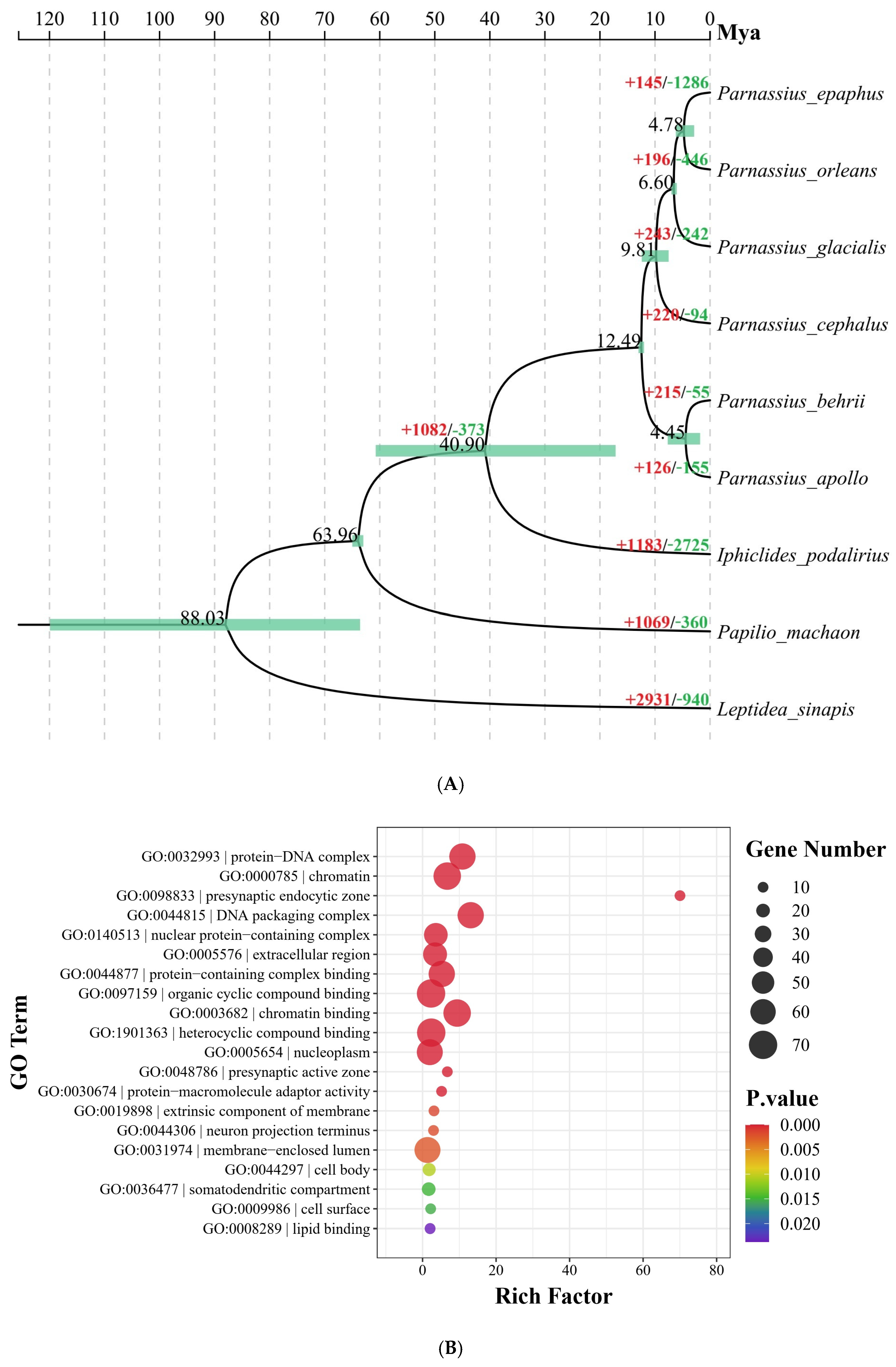

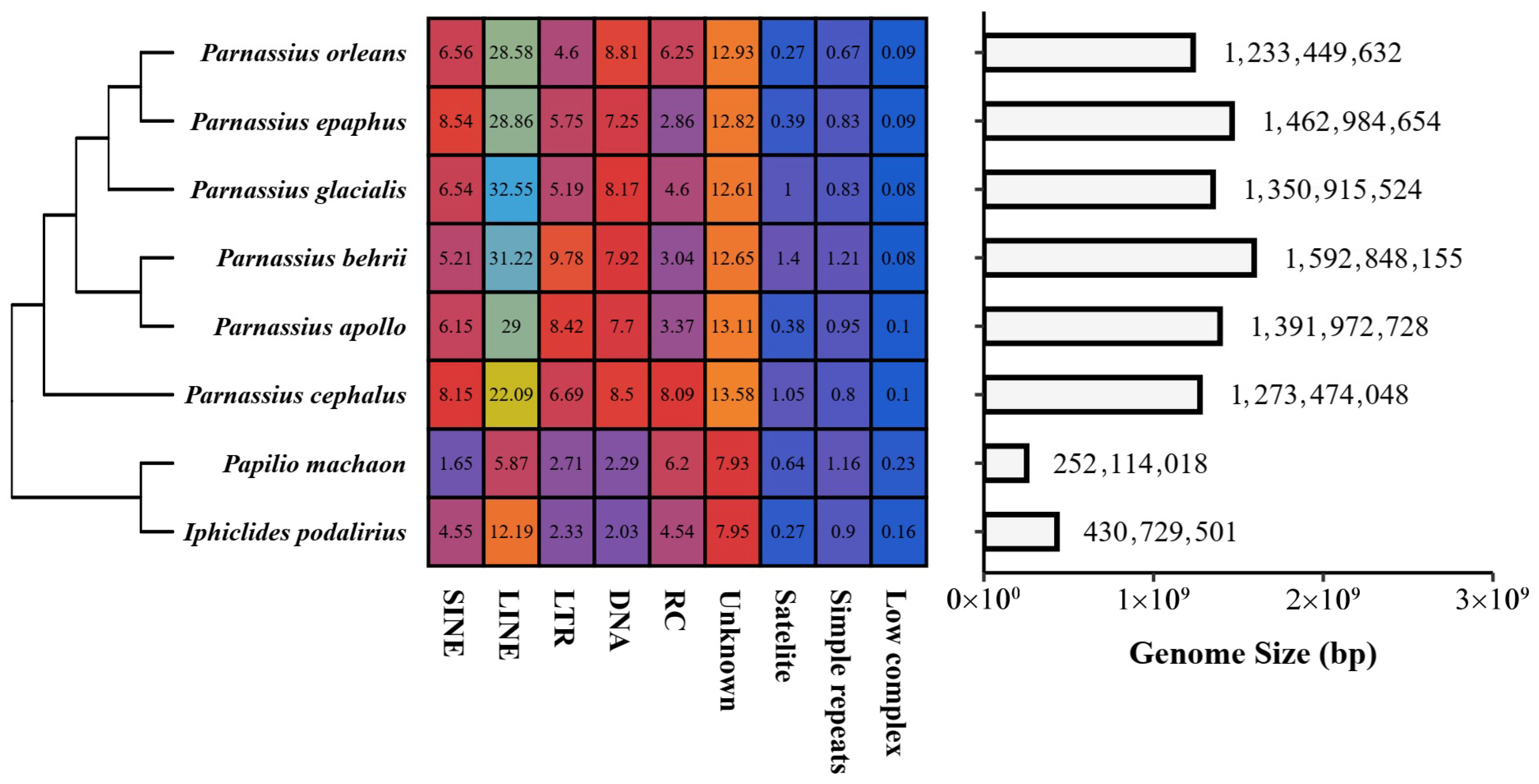
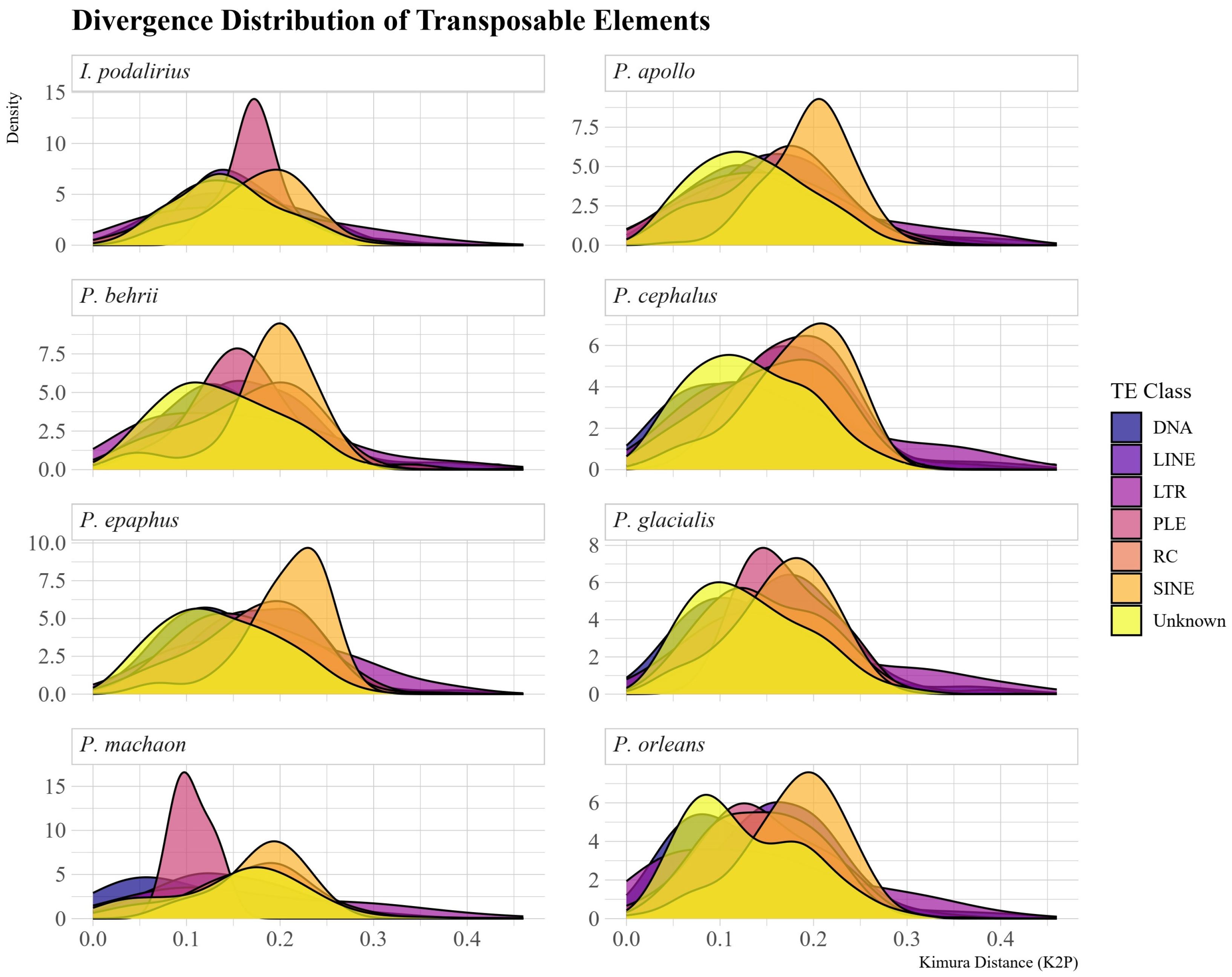
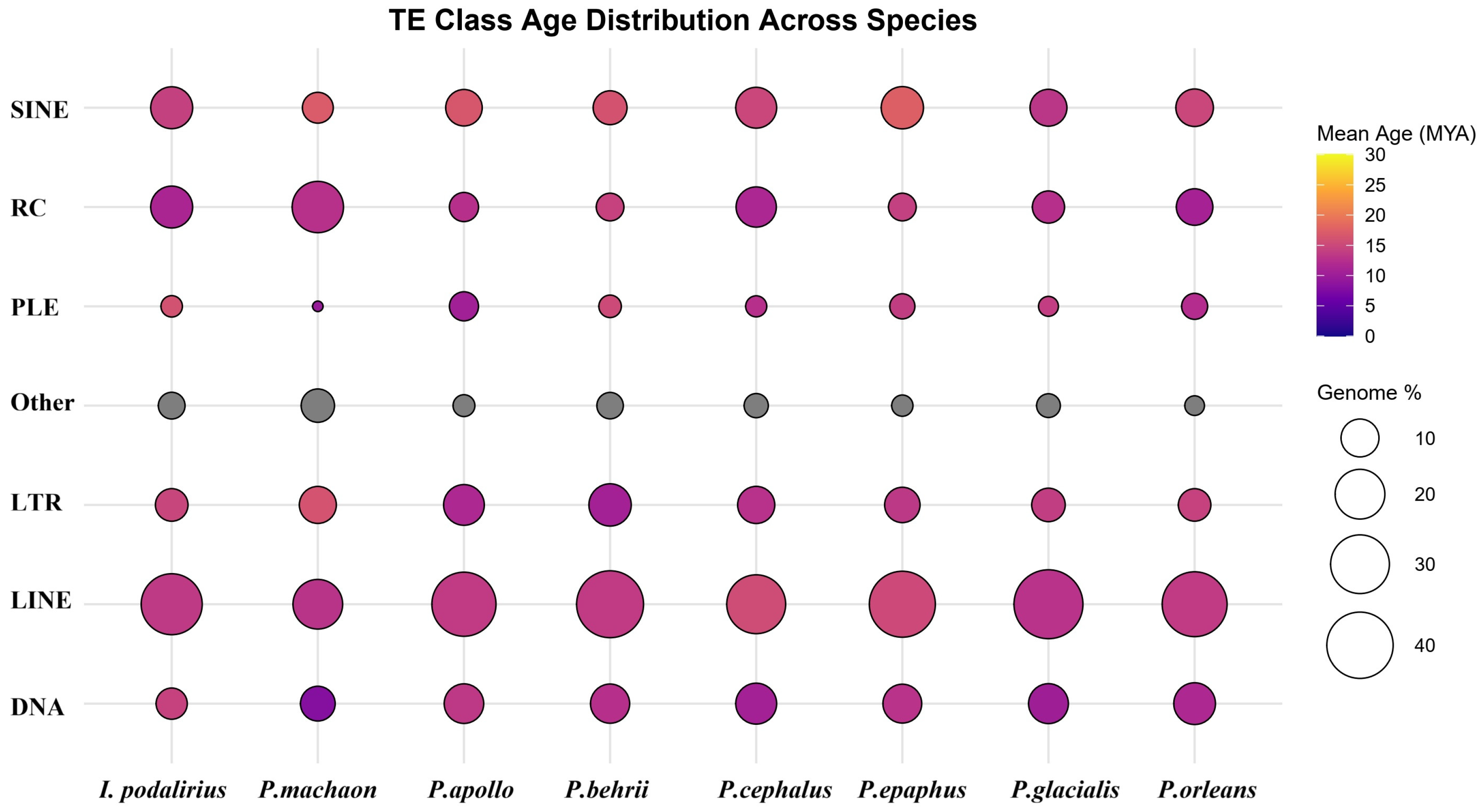

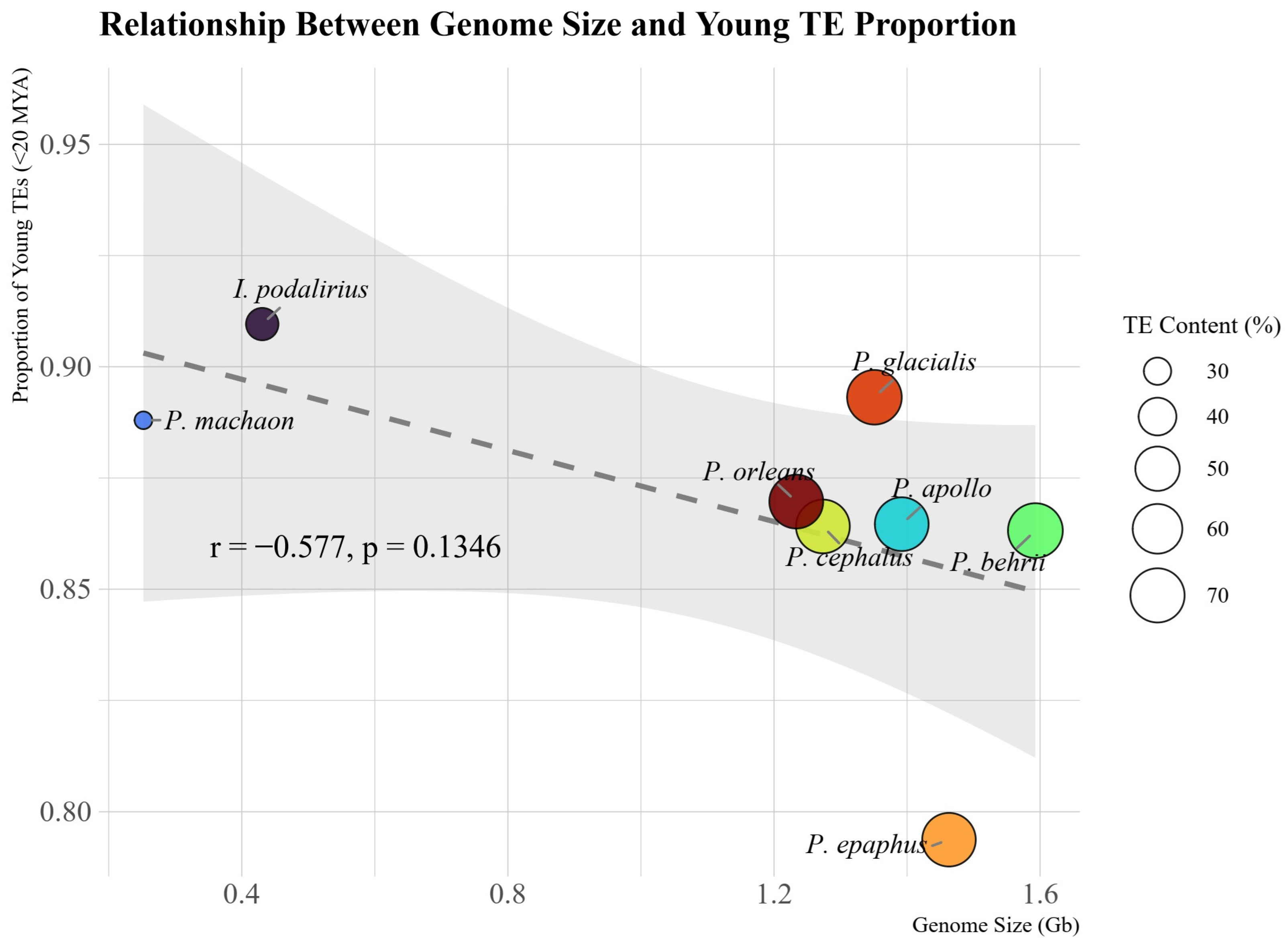
| Species | Genome Size (Gb) | GC (%) | Masked (%) | SINE (%) | LINE (%) | LTR (%) | DNA (%) | RC (%) | Unknown (%) | Satellite (%) | Simple Repeats (%) | Low Complex (%) |
|---|---|---|---|---|---|---|---|---|---|---|---|---|
| Leptidea sinapis | 0.69 | 35.73 | 63.55 | 0.00 | 31.95 | 1.87 | 4.56 | 0.71 | 24.12 | 0.34 | 0.71 | 0.00 |
| Iphiclides podalirius | 0.43 | 36.57 | 34.92 | 4.55 | 12.19 | 2.33 | 2.03 | 4.54 | 7.95 | 0.27 | 0.90 | 0.16 |
| Papilio machaon | 0.25 | 34.52 | 28.68 | 1.65 | 5.87 | 2.71 | 2.29 | 6.20 | 7.93 | 0.64 | 1.16 | 0.23 |
| Parnassius apollo | 1.39 | 37.42 | 69.20 | 6.15 | 29.00 | 8.42 | 7.70 | 3.37 | 13.11 | 0.38 | 0.95 | 0.10 |
| Parnassius behrii | 1.59 | 37.65 | 72.56 | 5.21 | 31.22 | 9.78 | 7.92 | 3.04 | 12.65 | 1.40 | 1.21 | 0.08 |
| Parnassius cephalus | 1.27 | 36.57 | 69.04 | 8.15 | 22.09 | 6.69 | 8.50 | 8.09 | 13.58 | 1.05 | 0.80 | 0.10 |
| Parnassius epaphus | 1.46 | 37.05 | 67.39 | 8.54 | 28.86 | 5.75 | 7.25 | 2.86 | 12.82 | 0.39 | 0.83 | 0.09 |
| Parnassius glacialis | 1.35 | 38.01 | 71.58 | 6.54 | 32.55 | 5.19 | 8.17 | 4.60 | 12.61 | 1.00 | 0.83 | 0.08 |
| Parnassius orleans | 1.23 | 37.09 | 68.75 | 6.56 | 28.58 | 4.60 | 8.81 | 6.25 | 12.93 | 0.27 | 0.67 | 0.09 |
Disclaimer/Publisher’s Note: The statements, opinions and data contained in all publications are solely those of the individual author(s) and contributor(s) and not of MDPI and/or the editor(s). MDPI and/or the editor(s) disclaim responsibility for any injury to people or property resulting from any ideas, methods, instructions or products referred to in the content. |
© 2025 by the authors. Licensee MDPI, Basel, Switzerland. This article is an open access article distributed under the terms and conditions of the Creative Commons Attribution (CC BY) license (https://creativecommons.org/licenses/by/4.0/).
Share and Cite
Rong, W.; Wei, N.; Song, J.; Qin, G.; Guan, D. Draft Genome Assembly of Parnassius epaphus Provides New Insights into Transposable Elements That Drive Genome Expansion in Alpine Parnassius butterflies. Diversity 2025, 17, 794. https://doi.org/10.3390/d17110794
Rong W, Wei N, Song J, Qin G, Guan D. Draft Genome Assembly of Parnassius epaphus Provides New Insights into Transposable Elements That Drive Genome Expansion in Alpine Parnassius butterflies. Diversity. 2025; 17(11):794. https://doi.org/10.3390/d17110794
Chicago/Turabian StyleRong, Wantao, Nan Wei, Jing Song, Guole Qin, and Delong Guan. 2025. "Draft Genome Assembly of Parnassius epaphus Provides New Insights into Transposable Elements That Drive Genome Expansion in Alpine Parnassius butterflies" Diversity 17, no. 11: 794. https://doi.org/10.3390/d17110794
APA StyleRong, W., Wei, N., Song, J., Qin, G., & Guan, D. (2025). Draft Genome Assembly of Parnassius epaphus Provides New Insights into Transposable Elements That Drive Genome Expansion in Alpine Parnassius butterflies. Diversity, 17(11), 794. https://doi.org/10.3390/d17110794






